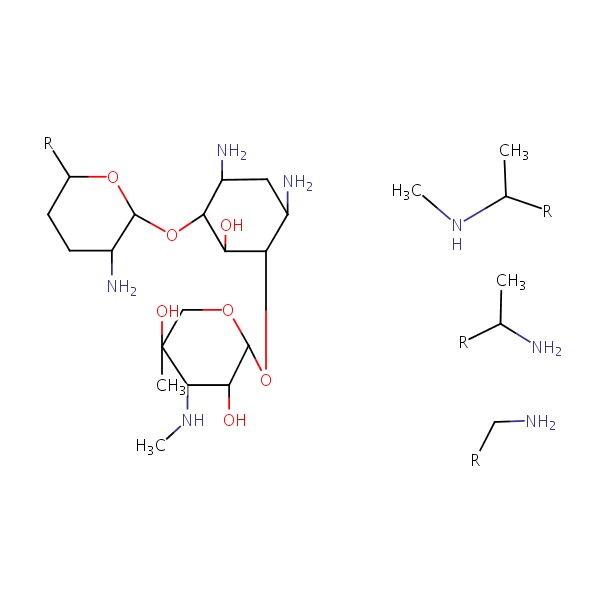NCBI Bookshelf. A service of the National Library of Medicine, National Institutes of Health.
LiverTox: Clinical and Research Information on Drug-Induced Liver Injury [Internet]. Bethesda (MD): National Institute of Diabetes and Digestive and Kidney Diseases; 2012-.

LiverTox: Clinical and Research Information on Drug-Induced Liver Injury [Internet].
Show detailsOVERVIEW
Introduction
Gentamicin is a parenterally administered, broad spectrum aminoglycoside antibiotic typically used for moderate to severe gram negative infections. Despite its wide use, gentamicin has not been definitively linked to instances of clinically apparent liver injury.
Background
Gentamicin (jen" ta mye' sin) is a aminoglycoside with broad bacteriocidal activity against many aerobic gram negative and some aerobic gram positive organisms. Gentamicin is the most commonly used aminoglycoside antibiotic and is indicated for moderate-to-severe bacterial infections caused by sensitive agents, primarily gram negative bacteria. Like other aminoglycosides, gentamicin is thought to act by binding to bacterial ribosomes and inhibiting protein synthesis. Nevertheless, gentamicin is considered bacteriocidal as well as bacteriostatic. Gentamicin and other aminoglycosides are typically used in combination with a penicillin or cephalosporin for treatment of severe infections with E. coli, Staphylococcus aureus, Enterobacter, Klebsiella, Serratia, Pseudomonas aeruginosa, and other gram negative bacteria resistant to less toxic antibiotics. Gentamicin is most commonly used for septicemia, bacterial endocarditis, peritonitis, meningitis, pelvic inflammatory disease and pneumonia. Gentamicin was first approved for use in the United States in 1970 and remains in wide use. Gentamicin is available in multiple generic parenteral formulations and the typical adult dose is 3 to 5 mg/kg per day im or iv, usually in three divided doses and often after a loading dose. Doses must be modified based upon renal function and monitoring of drug levels is advisable. Topical formulations are also available for local wound, tissue and ophthalmologic anti-bacterial therapy. Common side effects of gentamicin include dizziness, headache, confusion, nausea and skin rash. Important, dose related adverse effects include oto- and nephrotoxicity, which are shared by all aminoglycosides.
Hepatotoxicity
Intravenous and intramuscular therapy with gentamicin has been linked to mild and asymptomatic elevations in serum alkaline phosphatase levels, but rarely affects aminotransferase levels or bilirubin, and changes resolve rapidly once gentamicin is stopped. Only isolated case reports of acute liver injury with jaundice have been associated with aminoglycoside therapy including gentamicin, most of which are not very convincing. The hepatic injury described in these reports is typically mixed but can evolve into a cholestatic hepatitis. The latency to onset is rapid, occurring within 1 to 3 weeks and is typically associated with skin rash, fever and sometimes eosinophilia. Recovery typically occurs within 1 to 2 months and chronic injury has not been described. Aminoglycosides are not listed or mentioned in large case series of drug induced liver disease and acute liver failure; thus, hepatic injury due to gentamicin is rare if it occurs at all.
Likelihood score: E (unlikely cause of clinically apparent liver injury).
Mechanism of Injury
The cause of symptomatic, icteric hepatic injury from gentamicin is not known, but likely to be immunoallergic. Uptake of aminoglycosides into hepatocytes is limited and they are rapidly excreted in the urine; high concentrations are found in mainly in renal tubular cells and hair cells of inner ear perhaps explaining why they are more likely to cause nephro- or oto- rather than hepatotoxicity.
Outcome and Management
The outcome of hepatic injury due to aminoglycosides is usually benign. Acute liver failure has not been associated with gentamicin use and no convincing cases of chronic bile duct vanishing syndrome have been described after its use. Patients with clinical apparent reactions to gentamicin should probably avoid all systemic aminoglycoside use.
References to the safety and potential hepatotoxicity of gentamicin are provided in the Overview section on the Aminoglycosides.
Drug Class: Aminoglycosides
Other Drugs in the Class: Amikacin, Neomycin, Plazomicin, Streptomycin, Tobramycin
PRODUCT INFORMATION
REPRESENTATIVE TRADE NAMES
Gentamicin – Generic
DRUG CLASS
Aminoglycosides
Product labeling at DailyMed, National Library of Medicine, NIH
CHEMICAL FORMULA AND STRUCTURE
| DRUG | CAS REGISTRY NO. | MOLECULAR FORMULA | STRUCTURE |
|---|---|---|---|
| Gentamicin | 1405-41-0 | H2-O4-S.x-Unspecified |
 |
- PubChem SubstanceRelated PubChem Substances
- Review Tobramycin.[LiverTox: Clinical and Researc...]Review Tobramycin.. LiverTox: Clinical and Research Information on Drug-Induced Liver Injury. 2012
- Review Plazomicin.[LiverTox: Clinical and Researc...]Review Plazomicin.. LiverTox: Clinical and Research Information on Drug-Induced Liver Injury. 2012
- Review Amikacin.[LiverTox: Clinical and Researc...]Review Amikacin.. LiverTox: Clinical and Research Information on Drug-Induced Liver Injury. 2012
- Is gentamicin safe and effective for severe community-acquired pneumonia? An 8-year retrospective cohort study.[Int J Antimicrob Agents. 2018]Is gentamicin safe and effective for severe community-acquired pneumonia? An 8-year retrospective cohort study.Brereton CJ, Lennon D, Browning S, Dunn E, Ferguson JK, Davis JS. Int J Antimicrob Agents. 2018 Jun; 51(6):862-866. Epub 2018 May 18.
- Review Gentamicin Therapy and MT-RNR1 Genotype.[Medical Genetics Summaries. 2012]Review Gentamicin Therapy and MT-RNR1 Genotype.Dean L, Kane M. Medical Genetics Summaries. 2012
- Gentamicin - LiverToxGentamicin - LiverTox
Your browsing activity is empty.
Activity recording is turned off.
See more...